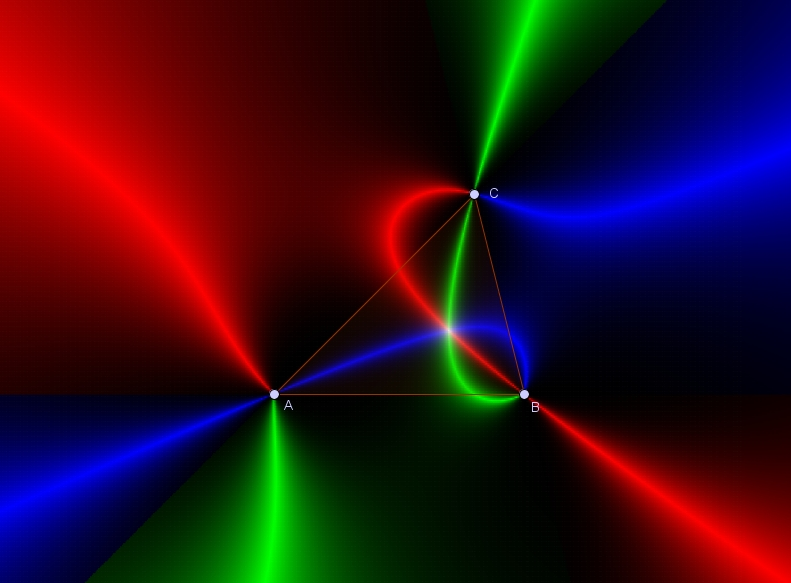Angles
This activity belongs to the GeoGebra book GeoGebra Principia.
The following is one of the images generated using the dynamic color scanner that I particularly like. The scanner has tremendous versatility, it can create a heat map for virtually any situation [3, 19, 26, 27, 31].
 In this case, the first isogonic point I1 is visualized by intersecting the loci that see each pair of sides of the triangle under the same angle.
In this case, the first isogonic point I1 is visualized by intersecting the loci that see each pair of sides of the triangle under the same angle.
 In this case, the first isogonic point I1 is visualized by intersecting the loci that see each pair of sides of the triangle under the same angle.
In this case, the first isogonic point I1 is visualized by intersecting the loci that see each pair of sides of the triangle under the same angle.
- Note: I1 coincides with the Fermat point when the triangle's largest angle is not greater than 120º; otherwise, the Fermat point coincides with the vertex corresponding to that angle. It can be calculated directly as the triangle's center X(13)
 :
:
I1 = TriangleCenter(O, A, B, 13).
However, constructing the scanner takes some effort. But we can use CAS to define not only distances but also angles. If someone still thinks that using the expression XA instead of sqrt((x − x(A))² + (y − y(A))²) doesn't save much work, perhaps they'll reconsider now when they can use the expression OXA, defined in the CAS view as: OXA(x,y):= Angle(O, X, A) instead of its algebraic equivalent (with O=(a,b) and A=(c,d)):- cos–1((a c – a x + b d – b y – c x – d y + x² + y²) sqrt(a² c² – 2a² c x + a² d² – 2a² d y + a² x² + a² y² – 2a c² x + 4a c x² – 2a d² x + 4a d x y – 2a x³ – 2a x y² + b² c² – 2b² c x + b² d² – 2b² d y + b² x² + b² y² – 2b c² y + 4b c x y – 2b d² y + 4b d y² – 2b x² y – 2b y³ + c² x² + c² y² – 2c x³ – 2c x y² + d² x² + d² y² – 2d x² y – 2d y³ + x⁴ + 2x² y² + y⁴) / (a² c² – 2a² c x + a² d² – 2a² d y + a² x² + a² y² – 2a c² x + 4a c x² – 2a d² x + 4a d x y – 2a x³ – 2a x y² + b² c² – 2b² c x + b² d² – 2b² d y + b² x² + b² y² – 2b c² y + 4b c x y – 2b d² y + 4b d y² – 2b x² y – 2b y³ + c² x² + c² y² – 2c x³ – 2c x y² + d² x² + d² y² – 2d x² y – 2d y³ + x⁴ + 2x² y² + y⁴))
- Note: Circles whose arcs span an angle OXA equivalent to XA radians have centers:
(O + A)/2 ± PerpendicularVector(OA)/(2 tan(XA))
And those that see segments OA and OB from the same angle: OXA – OXB = 0 Finally, the intersection of this latter locus with the one corresponding to the equation OXA – AXB = 0 is the sought-after Fermat point.Author of the construction of GeoGebra: Rafael Losada.